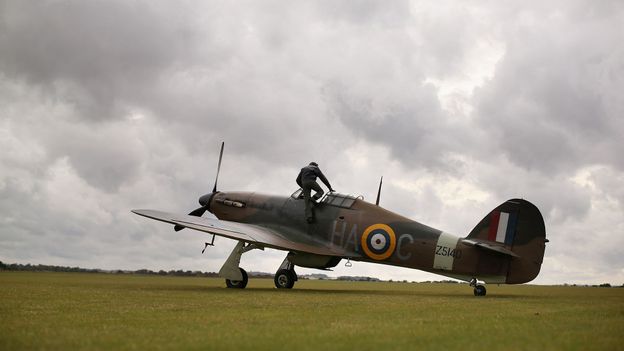Shortround6
Lieutenant General
And under.P-51 behind fo' sho.
Now maybe the top of the wing was enough separation between the fuel tanks and the cockpit but they were under cockpit.
Follow along with the video below to see how to install our site as a web app on your home screen.
Note: This feature may not be available in some browsers.
Ad: This forum contains affiliate links to products on Amazon and eBay. More information in Terms and rules
And under.P-51 behind fo' sho.
The forward tank looks close to where the CoG should be, but do wonder if the cockpit be moved forward and fueltank moved aft to keep similar balance
The top of the wing was 'uncovered' for NA-73X through NA-99 (P-51A). When the wing dropped 3 " for the XP-51B and all successive models, a floor was added to protect coolant and aft fuse fuel lines from clumsy feet.And under.
View attachment 716130
Now maybe the top of the wing was enough separation between the fuel tanks and the cockpit but they were under cockpit.
Not possible. Directly ahead of the pilot's feet is the firewall, ahead of that is the supercharger and carb. The fuel tank is above the feet and the supercharger.

So where is the CoG on the Hurricane? then can be calculated how much change there is from full to empty in both locations for moving that 28 imp. gallon tank, almost 219 pounds of fuel, and weight of sheet metal tank, what, 15-20 pounds for thatMoving the fuel tank around on an ai4frame cannot be done without serious consideration to CoG - not inly is the aircraft's CoG affected by a full tank, but it'll start shifting as the fuel is consumed.
Later model Spitfires had 2 level rudder pedals to improve G force toleranceYup, those pilots went up there to be shot at, sitting there with a big unarmored fuel tank in their laps. Brave guys.
IIRC one thing the Brits hadn't figured out yet (but some others had, including Germany IIRC ) was to have the pilot in a more reclining position which helped with G tolerance. But as a result, the cockpit would also be shallower. So in such a case, put the fuselage tank under the cockpit?
The CG will be relatively close (but not on) the 1/4 chord location, in this case near the firewall I would thinkSo where is the CoG on the Hurricane? then can be calculated how much change there is from full to empty in both locations for moving that 28 imp. gallon tank, almost 219 pounds of fuel, and weight of sheet metal tank, what, 15-20 pounds for that
there is some leeway, given a two-seater was done recently
View attachment 716189
duplicating a few that were done postwar
View attachment 716190
You are not wrong.Too many responses (including several excellent ones) to scan thru, but French engine development lagged in comparison to the UK and Germany. My impression is that available power limited the potential of available airframes.
The Army d'l Air's most successful fighter in 1939-40 was the export P-36, aka Hawk 75.
So moving the tank close to original seat location does move the CG aft, as expected, and will add slightly to C0G changes as fuel is burned, as the wing tanks already do.The CG will be relatively close (but not on) the 1/4 chord location, in this case near the firewall I would think
A great deal of thought goes into preliminary design - interactive as various fixed and consumable stores are positioned and re-positioned. The most important is the fuel and the fuel fraction as the designers/performance guys play with tankage - usually the most important consumable and most potential impact on static margins and cg travel for stability.So moving the tank close to original seat location does move the CG aft, as expected, and will add slightly to C0G changes as fuel is burned, as the wing tanks already do.
But advantage of 170 pound Pilot, his parachute, the seat and armored seatback is moving forward as well, reducing the tail heaviness caused by moving the tank aft.
Which brings up a question about the 85G fuselage tank in the Mustang. I'm sure this is covered in the excellent tome "Bastard Stepchild..." (which, shamefully, I have not actually read yet, my apologies) but did North American plan for that possibility? I mean, what was behind the pilot (other than the radio) in the early P-51 that space could be found for that big honking fuel cell?A great deal of thought goes into preliminary design - interactive as various fixed and consumable stores are positioned and re-positioned. The most important is the fuel and the fuel fraction as the designers/performance guys play with tankage - usually the most important consumable and most potential impact on static margins and cg travel for stability.
I would assume that the Hawker designers elected to go with their decision after exploring many options to improve hazard management for the amount of fuel required to meet the spec. Very few designers of Pursuit aircraft elected to put fuel in wings as wingtankage tended to force more weight into wing, make difficult decisions fat wing/thing wing for drag considerations, increase structural related weight, etc
radio, battery, iff.Which brings up a question about the 85G fuselage tank in the Mustang. I'm sure this is covered in the excellent tome "Bastard Stepchild..." (which, shamefully, I have not actually read yet, my apologies) but did North American plan for that possibility? I mean, what was behind the pilot (other than the radio) in the early P-51 that space could be found for that big honking fuel cell?
Or was it just a happy coincidence that that space was available?
As always, thanks.